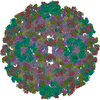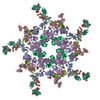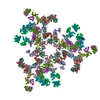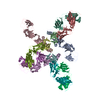[English] 日本語
 Yorodumi
Yorodumi- PDB-8fe4: Structure of dengue virus (DENV2) in complex with prM13, an anti-... -
+ Open data
Open data
- Basic information
Basic information
| Entry | Database: PDB / ID: 8fe4 | |||||||||
|---|---|---|---|---|---|---|---|---|---|---|
| Title | Structure of dengue virus (DENV2) in complex with prM13, an anti-PrM monoclonal antibody | |||||||||
 Components Components |
| |||||||||
 Keywords Keywords | VIRUS/IMMUNE SYSTEM / DENV / flavivirus / prM antibody / prM13 / VIRUS-IMMUNE SYSTEM complex | |||||||||
| Function / homology |  Function and homology information Function and homology informationsymbiont-mediated suppression of host JAK-STAT cascade via inhibition of host TYK2 activity / host cell mitochondrion / symbiont-mediated suppression of host JAK-STAT cascade via inhibition of STAT2 activity / symbiont-mediated suppression of host cytoplasmic pattern recognition receptor signaling pathway via inhibition of MAVS activity / ribonucleoside triphosphate phosphatase activity / viral capsid / double-stranded RNA binding / channel activity / monoatomic ion transmembrane transport / clathrin-dependent endocytosis of virus by host cell ...symbiont-mediated suppression of host JAK-STAT cascade via inhibition of host TYK2 activity / host cell mitochondrion / symbiont-mediated suppression of host JAK-STAT cascade via inhibition of STAT2 activity / symbiont-mediated suppression of host cytoplasmic pattern recognition receptor signaling pathway via inhibition of MAVS activity / ribonucleoside triphosphate phosphatase activity / viral capsid / double-stranded RNA binding / channel activity / monoatomic ion transmembrane transport / clathrin-dependent endocytosis of virus by host cell / methyltransferase cap1 activity / mRNA 5'-cap (guanine-N7-)-methyltransferase activity / RNA helicase activity / protein dimerization activity / host cell endoplasmic reticulum membrane / symbiont-mediated suppression of host type I interferon-mediated signaling pathway / symbiont-mediated activation of host autophagy / serine-type endopeptidase activity / viral RNA genome replication / RNA-directed RNA polymerase activity / fusion of virus membrane with host endosome membrane / viral envelope / virion attachment to host cell / host cell nucleus / virion membrane / structural molecule activity / proteolysis / extracellular region / ATP binding / metal ion binding / membrane Similarity search - Function | |||||||||
| Biological species |  Dengue virus type 2 Dengue virus type 2 | |||||||||
| Method | ELECTRON MICROSCOPY / single particle reconstruction / cryo EM / Resolution: 9.8 Å | |||||||||
 Authors Authors | Dowd, A.D. / Sirohi, D. / Speer, S. / Mukherjee, S. / Govero, J. / Aleshnick, M. / Larman, B. / Sukupolvi-Petty, S. / Sevvana, M. / Miller, A.S. ...Dowd, A.D. / Sirohi, D. / Speer, S. / Mukherjee, S. / Govero, J. / Aleshnick, M. / Larman, B. / Sukupolvi-Petty, S. / Sevvana, M. / Miller, A.S. / Klose, T. / Zheng, A. / Kielian, M. / Kuhn, R.J. / Diamond, M.S. / Pierson, T.C. | |||||||||
| Funding support |  United States, 2items United States, 2items
| |||||||||
 Citation Citation |  Journal: Proc Natl Acad Sci U S A / Year: 2023 Journal: Proc Natl Acad Sci U S A / Year: 2023Title: prM-reactive antibodies reveal a role for partially mature virions in dengue virus pathogenesis. Authors: Kimberly A Dowd / Devika Sirohi / Scott D Speer / Laura A VanBlargan / Rita E Chen / Swati Mukherjee / Bradley M Whitener / Jennifer Govero / Maya Aleshnick / Bridget Larman / Soila ...Authors: Kimberly A Dowd / Devika Sirohi / Scott D Speer / Laura A VanBlargan / Rita E Chen / Swati Mukherjee / Bradley M Whitener / Jennifer Govero / Maya Aleshnick / Bridget Larman / Soila Sukupolvi-Petty / Madhumati Sevvana / Andrew S Miller / Thomas Klose / Aihua Zheng / Scott Koenig / Margaret Kielian / Richard J Kuhn / Michael S Diamond / Theodore C Pierson /  Abstract: Cleavage of the flavivirus premembrane (prM) structural protein during maturation can be inefficient. The contribution of partially mature flavivirus virions that retain uncleaved prM to pathogenesis ...Cleavage of the flavivirus premembrane (prM) structural protein during maturation can be inefficient. The contribution of partially mature flavivirus virions that retain uncleaved prM to pathogenesis during primary infection is unknown. To investigate this question, we characterized the functional properties of newly-generated dengue virus (DENV) prM-reactive monoclonal antibodies (mAbs) in vitro and using a mouse model of DENV disease. Anti-prM mAbs neutralized DENV infection in a virion maturation state-dependent manner. Alanine scanning mutagenesis and cryoelectron microscopy of anti-prM mAbs in complex with immature DENV defined two modes of attachment to a single antigenic site. In vivo, passive transfer of intact anti-prM mAbs resulted in an antibody-dependent enhancement of disease. However, protection against DENV-induced lethality was observed when the transferred mAbs were genetically modified to inhibit their ability to interact with Fcγ receptors. These data establish that in addition to mature forms of the virus, partially mature infectious prM virions can also contribute to pathogenesis during primary DENV infections. | |||||||||
| History |
|
- Structure visualization
Structure visualization
| Structure viewer | Molecule:  Molmil Molmil Jmol/JSmol Jmol/JSmol |
|---|
- Downloads & links
Downloads & links
- Download
Download
| PDBx/mmCIF format |  8fe4.cif.gz 8fe4.cif.gz | 400.6 KB | Display |  PDBx/mmCIF format PDBx/mmCIF format |
|---|---|---|---|---|
| PDB format |  pdb8fe4.ent.gz pdb8fe4.ent.gz | 280.8 KB | Display |  PDB format PDB format |
| PDBx/mmJSON format |  8fe4.json.gz 8fe4.json.gz | Tree view |  PDBx/mmJSON format PDBx/mmJSON format | |
| Others |  Other downloads Other downloads |
-Validation report
| Summary document |  8fe4_validation.pdf.gz 8fe4_validation.pdf.gz | 1.2 MB | Display |  wwPDB validaton report wwPDB validaton report |
|---|---|---|---|---|
| Full document |  8fe4_full_validation.pdf.gz 8fe4_full_validation.pdf.gz | 1.3 MB | Display | |
| Data in XML |  8fe4_validation.xml.gz 8fe4_validation.xml.gz | 76.2 KB | Display | |
| Data in CIF |  8fe4_validation.cif.gz 8fe4_validation.cif.gz | 117.9 KB | Display | |
| Arichive directory |  https://data.pdbj.org/pub/pdb/validation_reports/fe/8fe4 https://data.pdbj.org/pub/pdb/validation_reports/fe/8fe4 ftp://data.pdbj.org/pub/pdb/validation_reports/fe/8fe4 ftp://data.pdbj.org/pub/pdb/validation_reports/fe/8fe4 | HTTPS FTP |
-Related structure data
| Related structure data |  29021MC  8fe3C M: map data used to model this data C: citing same article ( |
|---|---|
| Similar structure data | Similarity search - Function & homology  F&H Search F&H Search |
- Links
Links
- Assembly
Assembly
| Deposited unit | 
|
|---|---|
| 1 | x 60
|
| 2 |
|
| 3 | x 5
|
| 4 | x 6
|
| 5 | 
|
| Symmetry | Point symmetry: (Schoenflies symbol: I (icosahedral)) |
- Components
Components
| #1: Protein | Mass: 43892.469 Da / Num. of mol.: 3 Source method: isolated from a genetically manipulated source Source: (gene. exp.)  Dengue virus type 2 / Cell line (production host): C6/36 / Production host: Dengue virus type 2 / Cell line (production host): C6/36 / Production host:  #2: Protein | Mass: 9261.531 Da / Num. of mol.: 3 Source method: isolated from a genetically manipulated source Source: (gene. exp.)  Dengue virus type 2 / Cell line (production host): C6/36 / Production host: Dengue virus type 2 / Cell line (production host): C6/36 / Production host:  #3: Antibody | Mass: 23777.656 Da / Num. of mol.: 3 / Mutation: X1A,X2A Source method: isolated from a genetically manipulated source Details: The homology model of the prM13 variable heavy chain domain (1-118) was pieced together with the crystal structure of the constant heavy chain domain, derived from ZV-67, which belongs to ...Details: The homology model of the prM13 variable heavy chain domain (1-118) was pieced together with the crystal structure of the constant heavy chain domain, derived from ZV-67, which belongs to murine IgG2c isotype similar to prM13. Source: (gene. exp.)   Homo sapiens (human) Homo sapiens (human)#4: Antibody | Mass: 23245.510 Da / Num. of mol.: 3 / Mutation: X1A,X4A,X106A,X103A Source method: isolated from a genetically manipulated source Details: The homology model of the prM13 variable light chain domain (1-106) was pieced together with the crystal structure of the constant light chain domain, derived from ZV-67, which belongs to ...Details: The homology model of the prM13 variable light chain domain (1-106) was pieced together with the crystal structure of the constant light chain domain, derived from ZV-67, which belongs to murine IgG2c isotype similar to prM13. Source: (gene. exp.)   Homo sapiens (human) Homo sapiens (human) |
|---|
-Experimental details
-Experiment
| Experiment | Method: ELECTRON MICROSCOPY |
|---|---|
| EM experiment | Aggregation state: PARTICLE / 3D reconstruction method: single particle reconstruction |
- Sample preparation
Sample preparation
| Component | Name: Mus musculus / Type: VIRUS / Entity ID: all / Source: RECOMBINANT | ||||||||||||
|---|---|---|---|---|---|---|---|---|---|---|---|---|---|
| Molecular weight | Experimental value: NO | ||||||||||||
| Source (natural) |
| ||||||||||||
| Source (recombinant) |
| ||||||||||||
| Details of virus | Empty: NO / Enveloped: YES / Isolate: SEROTYPE / Type: VIRION | ||||||||||||
| Virus shell | Diameter: 500 nm / Triangulation number (T number): 3 | ||||||||||||
| Buffer solution | pH: 8 | ||||||||||||
| Specimen | Conc.: 5 mg/ml / Embedding applied: NO / Shadowing applied: NO / Staining applied: NO / Vitrification applied: YES | ||||||||||||
| Specimen support | Grid material: COPPER / Grid mesh size: 200 divisions/in. / Grid type: PELCO Ultrathin Carbon with Lacey Carbon | ||||||||||||
| Vitrification | Cryogen name: ETHANE |
- Electron microscopy imaging
Electron microscopy imaging
| Experimental equipment |  Model: Titan Krios / Image courtesy: FEI Company |
|---|---|
| Microscopy | Model: FEI TITAN KRIOS |
| Electron gun | Electron source:  FIELD EMISSION GUN / Accelerating voltage: 300 kV / Illumination mode: FLOOD BEAM FIELD EMISSION GUN / Accelerating voltage: 300 kV / Illumination mode: FLOOD BEAM |
| Electron lens | Mode: BRIGHT FIELD / Nominal magnification: 81000 X / Nominal defocus max: 2500 nm / Nominal defocus min: 1000 nm / Cs: 2.7 mm / C2 aperture diameter: 100 µm / Alignment procedure: COMA FREE |
| Specimen holder | Cryogen: NITROGEN / Specimen holder model: FEI TITAN KRIOS AUTOGRID HOLDER |
| Image recording | Electron dose: 30 e/Å2 / Detector mode: SUPER-RESOLUTION / Film or detector model: GATAN K2 SUMMIT (4k x 4k) |
- Processing
Processing
| EM software |
| |||||||||||||||||||||
|---|---|---|---|---|---|---|---|---|---|---|---|---|---|---|---|---|---|---|---|---|---|---|
| CTF correction | Type: PHASE FLIPPING AND AMPLITUDE CORRECTION | |||||||||||||||||||||
| Symmetry | Point symmetry: I (icosahedral) | |||||||||||||||||||||
| 3D reconstruction | Resolution: 9.8 Å / Resolution method: FSC 0.143 CUT-OFF / Num. of particles: 5458 / Symmetry type: POINT | |||||||||||||||||||||
| Atomic model building | Protocol: RIGID BODY FIT / Space: REAL | |||||||||||||||||||||
| Atomic model building |
| |||||||||||||||||||||
| Refinement | Highest resolution: 9.8 Å |
 Movie
Movie Controller
Controller



 PDBj
PDBj





